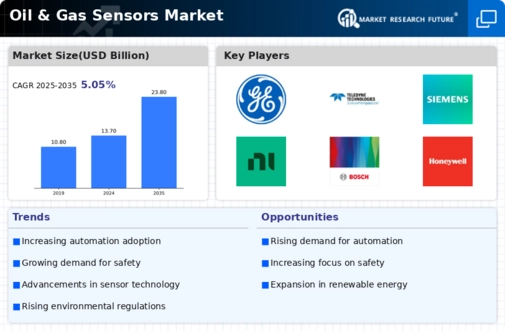Top Industry Leaders in the Oil Gas Sensors Market

*Disclaimer: List of key companies in no particular order
Latest Company Updates:
Competitive Landscape of Oil & Gas Sensors Market: Navigating a Dynamic Terrain
The oil and gas sensors market pulsates with fierce competition. Established players grapple with nimble contenders as technological advancements redefine the game. Understanding this dynamic landscape requires a multifaceted lens, considering key player strategies, market share determinants, and emerging trends.
Giants in the Arena: Leading the pack are established heavyweights like Honeywell, Siemens, and ABB. These behemoths leverage their extensive portfolios, global reach, and robust R&D capabilities to maintain market dominance. Honeywell, for instance, boasts integrated solutions encompassing sensors, software, and data analytics, catering to the entire oil and gas value chain. Similarly, Siemens emphasizes automation and digitalization, offering IIoT-enabled sensors for predictive maintenance and real-time insights.
Nimble Innovators: Disrupting the established order are smaller, agile players who capitalize on niche expertise and technological innovation. Startups like Akur8 and Endress+Hauser focus on specialized solutions like wireless acoustic emission sensors for pipeline monitoring or advanced corrosion detection technologies. Their quick adaptation to evolving needs enables them to carve out profitable segments within the broader market.
Market Share Mosaic: Analyzing market share goes beyond mere revenue figures. Factors like geographic presence, industry partnerships, and customer loyalty play crucial roles. Companies like Emerson and Rockwell Automation maintain strong footholds in North America, while Yokogawa and Schneider Electric reign supreme in Asia Pacific. Strategic partnerships with oil and gas majors like ExxonMobil or Shell can significantly boost market share, as demonstrated by GE's joint ventures in the Middle East.
Shifting Sands: New and emerging trends reshape the competitive landscape. The integration of Artificial Intelligence (AI) and machine learning into sensor technology paves the way for predictive maintenance, optimizing operations and minimizing downtime. Companies like Emerson are heavily invested in AI-powered diagnostics, while startups like SenseCom are developing AI-driven leak detection systems. Additionally, the surge in demand for wireless and IIoT-enabled sensors fuels the competition. Companies like Endress+Hauser are leading the charge with their wirelessHART technology, simplifying data collection and remote monitoring.
Collaboration Conundrum: While competition remains fierce, collaborative efforts are also on the rise. Consortiums like the Open Group Sensor Framework Consortium, comprising industry giants like ExxonMobil and ABB, aim to standardize sensor communication protocols, fostering interoperability and reducing fragmentation. Collaboration is also driven by the need for advanced solutions addressing complex challenges like offshore exploration or environmental compliance.
The Competitive Cauldron: The oil and gas sensors market boils with a potent mix of established players, emerging disruptors, and transformative technologies. To navigate this dynamic landscape, companies must:
Embrace Innovation: Continuous investment in R&D is crucial to develop cutting-edge sensor technologies and cater to niche market demands.
Prioritize Partnerships: Strategic alliances with oil and gas majors, technology providers, and even competitors can unlock new opportunities and accelerate market penetration.
Agility is Key: Adapting quickly to evolving demands, be it technological advancements or regulatory changes, is essential for sustained success.
Data-Driven Insights: Leveraging data analytics to optimize sensor performance, predict equipment failures, and improve operational efficiency will differentiate leaders from laggards.
The oil and gas sensors market is a dynamic arena where agility, innovation, and strategic partnerships hold the key to success. As technological advancements accelerate and industry demands evolve, the competitive landscape will undoubtedly continue to transform, presenting both challenges and opportunities for players across the spectrum.
Honeywell:
• Dec 2023: Announced development of next-generation XCVT pressure transmitter with improved accuracy and stability for upstream and downstream applications. (Source: Honeywell press release)
Emerson:
• Oct 2023: Launched Rosemount 3051S Smart Pressure Transmitter with wireless capabilities for remote monitoring and diagnostics. (Source: Emerson press release)
ABB:
• Nov 2023: Introduced the AbilityTM Smart Sensor family for condition monitoring and predictive maintenance in oil and gas assets. (Source: ABB press release)
GE:
• Nov 2023: Unveiled the Predix Edge Industrial IoT platform for on-site data processing and analytics in oil and gas operations. (Source: GE press release)
Rockwell Automation:
• Oct 2023: Released Allen-Bradley Smart Sensors with integrated EtherNet/IP connectivity for improved data integration and control. (Source: Rockwell Automation press release)
Top listed global companies in the industry are:
Honeywell, Emerson, ABB, GE, Rockwell, Siemens, TE Connectivity, BD Sensors, Lord, Fortive, and Bosch

